 |
Introduction
Everyone has heard about the DSLR. The first thing that comes to most peoples mind is amazing picture quality and a seemingly endless amount of options and adjustments, but with the drawbacks of being a heavy, bulky brick that can have a very steep learning curve and an even steeper price. On the other end of the spectrum there are the point and shoots. People love them because they are extremely portable, easy to use, and cheap at the expense of lower picture quality and virtually no setting adjustments.
But what many people don’t realize is that there is a middle ground. You can get amazing pictures with little to no experience while at the same time maintaining the portability.
Today we are taking a look at Samsung’s “middle ground” camera, the NX100. This camera is what is known as a mirrorless interchangeable lens camera meaning that it does not use the mirror system of a regular DSLR to display an exact image of what the lens sees to the optical viewfinder.
Basically this camera offers a DSLR-sized APS-C sensor, swappable lenses, and a hot shoe for expandability while keeping the small form factor and low weight. Read on to find out just what this camera is capable of.
 |
Specifications
| Camera Type | Interchangeable Lens |
| Effective Pixel | 14.6 |
| Image Sensor Type | 23.4×15.6mm |
| Lens Type | 20-50mm F3.5-5.6 iFunction Lens |
| Lens Mount | Samsung NX Mount |
| Shutter Speed | 1/4000sec ~ 30sec |
| Exposure Compensation | ±3 EV (1/3EV step) |
| ISO Equivalent | Auto, 100, 200, 400, 800, 1600, 3200 (1EV or 1/3EV step) Extension settable : ISO 6400 , Auto ISO upper level is selectable. (Up to ISO 1600) |
| Metering System | Metering:Multi, Center-weighted, Spot Metering range:EV0-18 (ISO100•30mm F2.0) |
| Focusing Modes | Single AF, Continuous AF, MF |
| Drive Modes | Smart Auto, Lens Priority, Program, Shutter Priority, Aperture Priority , Manual, Scene, Movie |
| RAW Format Shooting | SRW |
| Full Manual Controls |
Yes |
| LCD Screen | 3″ AMOLED Display |
| HD Video | 720p HD |
| White Balance Modes | Auto, Daylight, Cloudy, Fluorescent (W, N, D), Tungsten, Flash, Custom, K(Manual) |
| Sync. Speed | Less than 1/180sec. |
| Dust Reduction | Yes |
| File Formats | RAW (SRW), JPEG (EXIF 2.21), DCF, DPOF 1.1, PictBridge 1.0 |
| Image Sizes | JPEG (3:2) : 14M (4592×3056), 10M, 6M, 2M, 1.4M JPEG (16:9) : 12M (4592×2584), 8M, 5M, 2M JPEG (1:1) : 9M (3056×3056), 6.7M, 4M, 1.6M RAW : 14M (4592×3056) |
| Media | SD, SDHC |
| AV Out | NTSC, PAL |
| HDMI | 1.3 |
| USB 2.0 | Yes |
| Weight | 0.62 |
Features
- 14.6-megapixel APS-C CMOS Image Sensor
- Super Sonic Drive dust reduction system
- NX Lens Mount
- 3.0-inch AMOLED display with 614k dots and 100% frame coverage
- Fast, 15-point Contrast AF system with AF-assist lamp
- 20 shooting modes including Smart Auto, new Lens Priority and 14 scene modes
- RAW image file saving (RAW+JPEG available)
- Shutter speeds of 1/4000sec. ~ 30sec.
- Exposure compensation: ±3 EV in 1/3EV steps
- Two optical image stabilization modes when using OIS equipped lenses
- Continuous mode shooting at up to 3fps @ full resolution
- Burst mode captures 1.4M images at up to 30fps
- Spot, Center Weighted and Multi. Metering Settings
- Hot shoe for external flash units
- Powered by Rechargeable Lithium Ion Battery
- HDMI compatible
- SD/SDHC card slot
- Li-ion battery and charger
- Optional accessories: EVF, GPS Module, Flash, etc.
Packaging
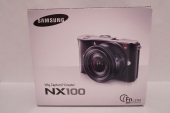 |
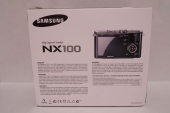 |
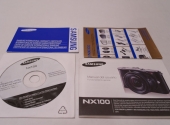 |
The NX100 comes in a plain back box with a white sleeve cover that you see here. The top of the box lists of few key features while the back gives the full list in multiple languages.
Included along with the camera itself is the owner’s manual, warranty information, a driver cd, and a full list of Samsung camera accessories as well as a charger which is not pictured.
A Closer Look
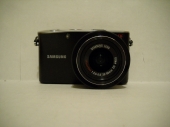 |
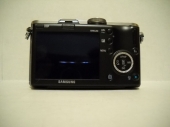 |
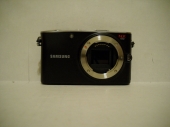 |
Now we can get a good look at the camera itself. Here we the front and back of the camera with and without the lens installed. One thing that Samsung did with the NX100 is reduce the bulkiness of the camera by giving the body the slender standard digital camera shape. While this does reduce overall size, it also reduces grip, made even worse by the smooth untextured surface. This proved to not a major issue.
The button scheme is intuitive and very easy to use. When shooting in full manual mode, every setting is easily adjustable on the fly. The AMOLED screen is extremely crisp and bright, better than any camera I have ever used.
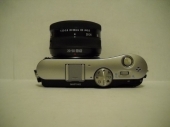 |
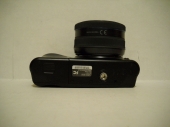 |
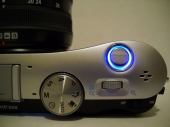 |
Here we see the top and bottom of the camera and also get an idea of the size of the lens compared to the body. While Samsung has shaved a significant amount of weight and size from a full size DSLR, this isn’t a tiny camera. But it will fit easily in a purse or small bag and maybe even a baggy pocket, though that may not be too comfortable.
In the rightmost picture we see the mode selector wheel as well as the jog wheel under the shutter button that controls shutter speed in manual mode. Next to the is a small speaker for playing back videos and on the left of the selector wheel is the microphone.
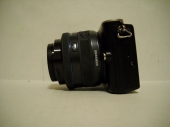 |
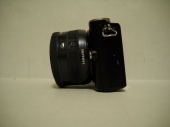 |
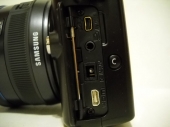 |
When the camera is in use, the lens is in the position seen in the left picture. But when you are done shooting, you can lock the lens back to both protect it from damage and make the camera slightly more portable.
As far as weight distribution, I found the NX100 to be fairly balanced. It is slightly front heavy compared to a full DSLR with a comparable lens, but when holding it in shooting position, I had no problems with balance.
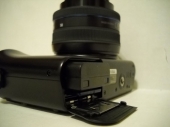 |
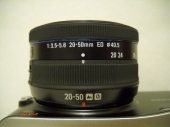 |
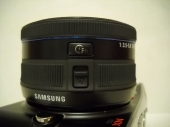 |
The battery and memory card are located in a small compartment on the bottom of the camera. The lens included with the kit we received is a 20-50mm with a 3.5-5.6 f-stop. One of the key features of this camera is its iFunction (iFn) lens. iFunction gives you instant access to all important settings such as shutter speed, aperture, ISO, and white balance and allows you to adjust them with the focus ring.
I personally found this feature fairly useless, finding it easier to adjust all of those functions with the different wheels and buttons on the rear. However, if you were to use the view finder attachment, I could see the iFn being very useful.
Under the iFn button we have the locking lever for the lens, allowing you to bring the lens to its smaller form factor.
Shooting Modes
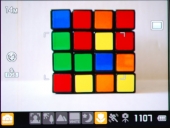 |
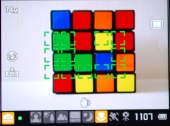 |
Smart Auto Mode: This mode is your easy mode. You simply turn the camera on, point it at something, and push the button. The camera will adjust shutter speed, aperture, metering, white balance, and exposure compensation to (theoretically) give you the optimal picture every time with no effort. Of course, the system is not perfect and can’t give absolutely ideal shots every time but I found that the auto mode was actually quite good and chose settings very close to what I would have chosen in manual. This setting is perfect if you are just starting to get into cameras or if you just want to grab a quick shot and not tinker with settings.
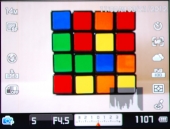 |
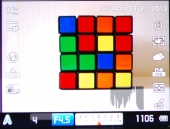 |
Program Mode (left): In this mode, the camera will adjust aperture and shutter speed depending on your lighting. You can also shift the settings so that as you increase shutter speed, aperture decreases (and vice versa). This is useful if you want to keep a constant exposure while being able to adjust other settings such as ISO and white balance.
Aperture Priority Mode (right): This mode allows you to adjust aperture while shutter speed is automatically adjusted to keep an optimal exposure. This mode is for someone who wants to specifically control their depth of field.
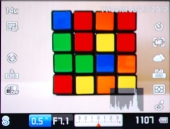 |
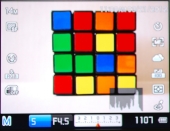 |
Shutter Priority Mode (left): Shutter priority mode is the exact opposite of aperture priority mode. You adjust shutter speed and the camera adjusts aperture. This mode is useful because you can choose to either freeze objects in place or give a speed blur effect.
Manual Mode (right): As you would expect, in this mode you have full control over all of the settings. Aperture and shutter speed are adjusted independently to fully control exposure. Samsung states that this mode is best for controlled environments such as a studio where settings can be fine-tuned. However, I found myself in this mode more than the other simply due to the control you have over your photo.
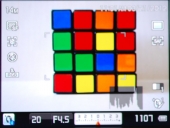 |
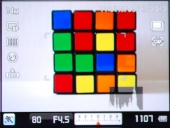 |
Lens Priority Mode (left): In this mode, you use the iFn button and the focus ring to select a scene that best matches what you are trying to capture. You have choices such as beauty shot, portrait, children, and landscape that give you a little more control without being overwhelming.
Scene Mode (right): Scene mode seems to be basically the same as lens priority mode except that you get a few more settings in each scene and a few more scene choices to choose from.
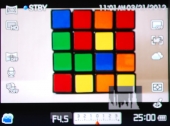 |
Movie Mode: Finally there is movie mode which lets you shoot HD 720p video. There are very limited settings to be adjusted in this mode but you can choose to let the camera automatically adjust aperture depending on lighting or you can do it manually. Aside from that you have control over the focus if you choose and that is about it. Video quality with the NX100 was pretty good overall aside from the fairly heavy rolling shutter effect that you get when the camera is panned quickly. See the test video in the sample photos section.
Menu Options
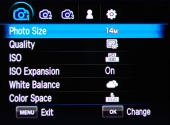 |
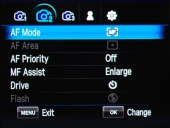 |
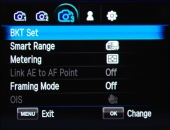 |
When you hit the menu button in any shooting mode you are greeted by this. These pictures were taken while in manual mode because it allows for more options in the menus. Within a few clicks we have access to photo size and quality, ISO settings, white balance and color options. In the next menu we see focus settings and drive modes (single, continuous, burst, etc.) while the third lets us set metering along with a few other settings.
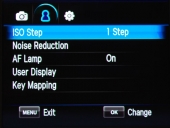 |
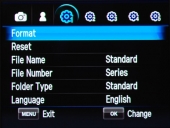 |
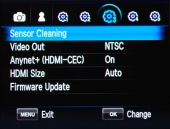 |
After the options menus, we have access to camera settings such as formatting the SD card, how we want to name files, etc. Also in this set of menus is the ability to clean the sensor of dust with ultrasonic sound.
Quick Access Menus
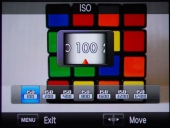 |
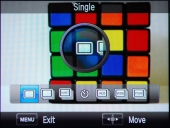 |
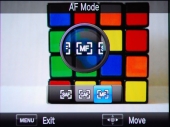 |
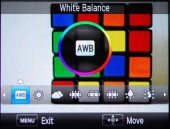 |
The quick access menus are accessible by pressing the four buttons inside of the silver wheel on the back of the camera. From these menus you can quickly adjust ISO, drive mode, auto focus settings, and white balance. These menus are very handy and you can make all of the adjustments you need in just a few seconds.
Fn Menu
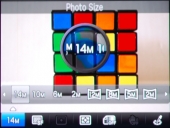 |
Above and to the right of the quick access menu buttons is the Fn menu. This menu is just another access point to change your photo size and quality, metering, and smart range. Though I tended to not use this menu very much, it is nice to have the option to should someone else find it more convenient.
Playback Options
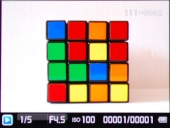 |
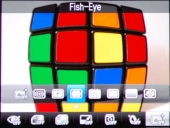 |
By pressing the play button to the bottom left of the quick access menu buttons you enter the playback mode. Here you can view pictures that you have taken and even do a little post-processing. We will get into some of the effects you can choose from later on.
NX100 vs Nikon D80
To start the quality tests we will take a quick look at the NX100 vs a full DSLR, the Nikon D80 in a few different settings.
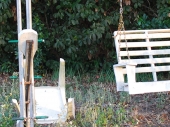 |
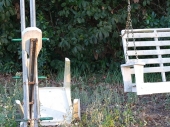 |
| D80 | NX100 |
Here is a crop of the same scene taken on each camera. The NX100 was equally as good as the D80 in this situation.
| D80 | NX100 |
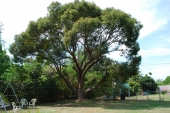 |
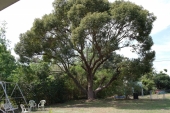 |
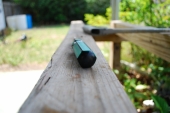 |
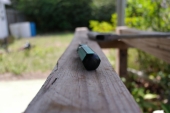 |
 |
 |
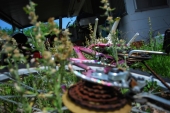 |
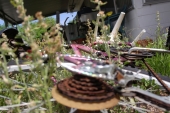 |
In these pictures you can see that the NX100 does an excellent job keeping up with the D80 and seemed to get more accurate color representation compared to the D80 which tended to over saturate.
ISO Comparison
In this test we will increase the ISO one step each time from 100 up to 1600. For comparison, we took pictures of the same scene with the D80 to try and get an idea of just how the NX100 stacks up. Each camera was sitting on a tripod with the settings adjusted accordingly for the lighting. We then cropped the picture down to a very small portion so that we can really see the strengths and weaknesses.
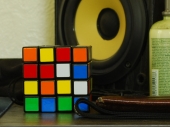 |
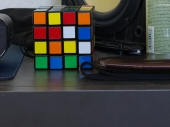 |
| D80 – 100 ISO | NX100 – 100 ISO |
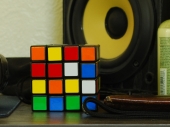 |
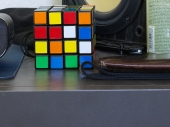 |
| D80 – 200 ISO | NX100 – 200 ISO |
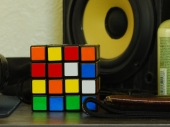 |
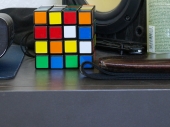 |
| D80 – 400 ISO | NX100 – 400 ISO |
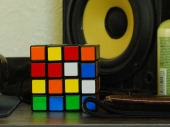 |
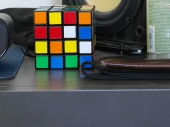 |
| D80 – 800 ISO | NX100 – 800 ISO |
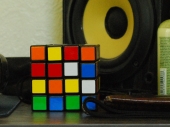 |
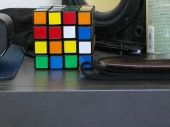 |
| D80 – 1600 ISO | NX100 – 1600 ISO |
As we can see from these side-by-side photos, at low ISO the NX100 is just as sharp as the D80 and the overall colors are actually a little better, though white balance has a lot to do with that.
As ISO increases, the NX100 steadily loses quality until 1600 has a noticeable amount of noise, as opposed to the D80 which retains its composure fairly well all the way up to 1600 where it still is not too bad.
Keep in mind that these are highly magnified crops and we are essentially pixel peeping at 10% of the total picture. When looking at the entire picture, even at 1600, the NX100 is not bad unless you are staring at shadows and such.
Ultra High ISO
In the previous test we used what most people would use for the majority of situations. However, the NX100 is capable of pushing the ISO even higher to 3200 and even 6400.
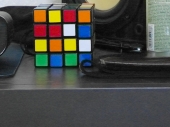 |
 |
On the left we have 3200 and the right 6400. As you can see, image quality degrades exponentially at these settings. Both 3200 and 6400 in my opinion are fairly useless on the NX100 and at this point you only have a few options. Either set ISO lower and use a tripod/set the camera on something so that you can use a slower shutter speed, or get the flash addon.
–~~~~~~~~~~~~–
File Quality
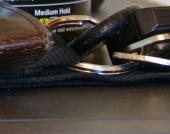 |
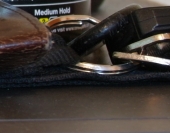 |
| RAW | Super Fine |
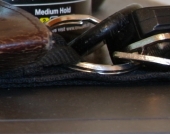 |
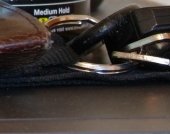 |
| Fine | Normal |
The NX100 gives the option to change file quality, which when lowered shaves significant amounts off of the file size at the theoretical compromise of image quality. However, from my testing and all of the pixel peeping I could do, I see virtually no difference between a 26MB RAW file and a 3MB normal file.
In order to try and squeeze any possible difference from the quality change, I shot at 800 ISO and took a picture of a towel. The reason behind this is that the minute differences tend to come out when shooting something with a lot of very small detail, such as hair or in this case a fuzzy towel.
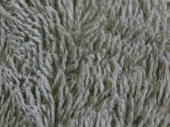 |
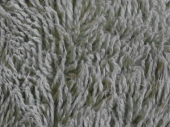 |
| RAW | Super Fine |
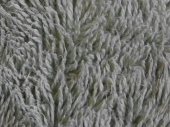 |
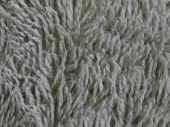 |
| Fine | Normal |
Even in this extreme case with a super close-up crop of a highly detailed subject with higher ISO, I can see no difference between RAW and normal. So don’t feel like if you aren’t shooting RAW you aren’t getting the full potential of your camera. Also, if you have a small SD card such as 1 or 2GB, you can safely bump the quality down and fit 2-3 times more photos on than when shooting at the standard super fine.
Fun Effects
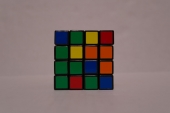 |
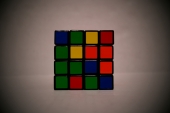 |
| Normal | Vignetting |
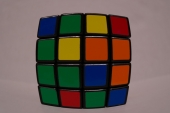 |
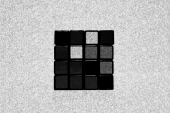 |
| Fisheye | Sketch |
Here are just a few examples of the different effects you can apply to an image after it has been taken. They aren’t massively impressive but can be pretty fun to mess around with and are super easy to use.
 |
 |
One effect that I found particularly interesting is the miniature effect which basically tries to imitate a tilt-shift lens. It is obviously no where near the real thing but is still interesting when shooting something far away and down low.
Shooting with the NX100
Taking pictures with the NX100 is a breeze for any skill level. For someone upgrading for the first time from their point-and-shoot and not quite comfortable with adjusting many settings, you can very easily choose exactly how much control you want and of what settings. Even if you use this camera like a standard point-and-shoot, you can still get high quality pictures in most situations, and you always have the option later on to unlock more settings should you choose.
Physically, the NX100’s shape and weight are pretty good. The body is fairly small compared to the lens but, as I mentioned earlier, does not lead the camera to be unbalanced. Also as I had previously mentioned, in order to make the body so small, Samsung had to remove the large grip found on most DSLRs, which when combined with the smooth surface of the body, gives you a little less confidence in your hold on the camera. I didn’t find this to be a major issue, but a little texture would have been nice.
As far as button and menu layout, I found them both very intuitive and quick. One of the key features of this camera is its iFunction button but I tended to never really use it and instead used the different wheels and buttons on the back of the camera to adjust my settings. Adjusting ISO, shutter speed, aperture, and white balance can all be done in a matter of seconds so you don’t miss that perfect shot. One of my favorite parts of the NX100 is the focus ring. Unlike other cameras such as the D80 that I tested against, the focus is changed much more slowly which allows you to perfectly dial in focus every time.
One things that I both love and hate about the NX100 is the 3″ AMOLED display. The display is amazingly crisp and gives you an accurate representation of what your photo will look like on a bigger screen. What I didn’t like is that because there is no viewfinder built-in, you are forced to use the display for everything. This gives you two major problems. First, it drains the battery extremely fast. Samsung says that you should be able to get about 420 photos on a charge which may seem like a lot until you realize that most DSLRs such as the D80 get 2500-3000 shots on a single charge because they only use the LCD occasionally. Secondly, when shooting in bright sunlight, it can be very hard to see the screen clearly. I mainly noticed this problem when trying to manually focus and simply being unable to tell when in focus. This issue can be fixed with the add-on viewfinder but that is an extra $75-100.
The only other issue I had with this camera is its low light capabilities. With the large APS-C sensor one would expect better but when the lights go slightly less than optimal, the ISO quickly needs to start rising and the shutter speed plummeting. And as you saw in the ISO comparisons, after about the 800 mark, you are going to be sacrificing a significant amount of quality. Like the LCD problem, this too can be fixed with an add-on, a flash in this case, but you are looking at another ~$70.
Conclusion
Pros:
- Capable of taking very high quality photos
- Much smaller than a DSLR
- Much more control than a point-and-shoot
- 3″ AMOLED display is great
- Extremely easy-to use for any skill level
- Capability of expanding with different lenses and accessories
Cons:
- No built-in viewfinder leads to a few problems
- No built-in flash severely limits low-light shots
- Battery life is fairly short
Now, after reading my experience with the NX100, it may seem as if I am being harsh or picky, but it is only because aside from those mentioned problems, the camera was fantastic. When the lighting is good, this camera takes beautiful pictures that in many cases can go toe-to-toe with DSLRs. Pictures are absolutely crisp and clear, with very accurate colors with very little to no tinkering of settings. Anyone can pick this camera up, set it on auto, point at something, press the shutter, and end up with a fantastic picture. Then when you are more comfortable, you can gradually ease into more controls until you control everything and are taking awesome photos.
In total, I was impressed with the NX100. Samsung wanted to take everything we love about a DSLR and compress it down to a small and easy-to-use package with as little sacrifices as possible. Of course, if these sacrifices are a deal-breaker for you, there are plenty of other options out there that can fit exactly what you want. But if you are looking for a relatively inexpensive, comparatively portable, and easy-to-use digital camera that is capable of taking some great pictures out of the box with plenty of room to expand down the road, then the NX100 may just be the camera for you.
Sample Photos
 |
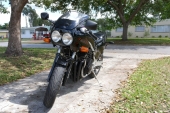 |
 |
 |
 |
 |
 |
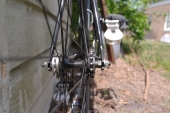 |

Would like to have seen this compared more to the Canon G12 or G1 X. This is informative to see how it compares to an older DSLR, but the D80 has been discontinued since 2008. You’re also comparing a 10.2MP DSLR, to a 14.6MP point and shoot. The overall look at the camera is good, however the comparison seems a bit useless
The focus was not really on NX100 vs D80 but more on mirrorless vs DSLR. Because this camera is aimed at someone looking to upgrade from a standard point and shoot they can get an idea of how this less-expensive option stacks up to the full DSLR. Besides, the D80 can still take excellent pictures.
As far as 10.2 vs 14.6MP, we are talking massive vs more massive. The only benefit is that you can crop the NX100 further while maintaining clarity. Once you resize down to a usable level the MP difference is negligible.
I would have loved to compare to a more modern DSLR, high-end point and shoot, or another mirrorless but resources are limited.